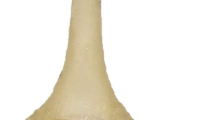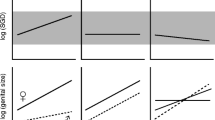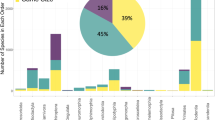Abstract
The rapid divergence of genitalia is a pervasive trend in animal evolution, thought to be due to the action of sexual selection. To test predictions from the sexual selection hypothesis, we here report data on the allometry, variation, plasticity and condition dependence of baculum morphology in the house mouse (Mus musculus domesticus). We find that that baculum size: (a) exhibits no consistent pattern of allometric scaling (baculum size being in most cases unrelated to body size), (b) exhibits low to moderate levels of phenotypic variation, (c) does not exhibit phenotypic plasticity in response to differences in perceived levels of sexual competition and (d) exhibits limited evidence of condition dependence. These patterns provide only limited evidence in support of the sexual selection hypothesis, and no consistent support for any particular sexual selection mechanism; however, more direct measures of how genital morphology influences male fertilization success are required.


Similar content being viewed by others
References
Andrade CAC, Hatadani LM, Klaczko LB (2005) Phenotypic plasticity of the aedeagus of Drosophila mediopunctata: effect of the temperature. J Therm Ecol 30:518–523
Andrade CAC, Vieira RD, Ananina G, Klaczko LB (2009) Evolution of male genitalia: morphological variation of the aedeagi in a natural population of Drosophila mediopunctata. Genetica 135:13–23
Arnqvist G (1997) The evolution of animal genitalia: distinguishing between hypotheses by single species studies. Biol J Linn Soc 60:365–379
Arnqvist G, Danielsson I (1999) Copulatory behavior, genital morphology, and male fertilization success in water striders. Evolution 53:147–156
Arnqvist G, Thornhill R (1998) Evolution of animal genitalia: patterns of phenotypic and genotypic variation and condition dependence of genital and non-genital morphology in water strider (Heteroptera: Gerridae: Insecta). Genet Res 71:193–212
Badyaev AV, Duckworth RA (2003) Context-dependent sexual advertisement: plasticity in development of sexual ornamentation throughout the lifetime of a passerine bird. J Evol Biol 16:1065–1076
Bertin A, Fairbairn DJ (2007) The form of sexual selection on male genitalia cannot be inferred from within-population variance and allometry–a case study in Aquarius remigis. Evolution 61:825–837
Bjork A, Dallai R, Pitnick S (2007) Adaptive modulation of sperm production rate in Drosophila bifurca, a species with giant sperm. Biol Lett 3:517–519
Bonduriansky R (2007) Sexual selection and allometry: a critical reappraisal of the evidence and ideas. Evolution 61:838–849
Bondurianksy R, Day T (2003) The evolution of static allometry in sexually selected traits. Evolution 57:2450–2458
Bronson FH (1979) The reproductive ecology of the house mouse. Q Rev Biol 54:265–299
Burt W (1960) Bacula of North American mammals. Misc Publ Mus Zool Univ Mich 113:1–75
Çolak E, Yiğit N, Sözen M, Çolak R, Özkurt S, Kankiliç T (2006) The morphological analysis of Mus domesticus and Mus macedonicus (Mammalia: Rodentia) in Turkey. Turk J Zool 30:309–317
Cordoba-Aguilar A (1999) Male copulatory sensory stimulation induces female ejection of rival sperm in a damselfly. Proc R Soc B 266:779–784
Danielsson I, Askenmo C (1999) Male genital traits and mating interval affect male fertilization success in the water strider Gerris lacustris. Behav Ecol Sociobiol 46:149–156
Dean MD, Ardlie KG, Nachman MW (2006) The frequency of multiple paternity suggests that sperm competition is common in house mice (Mus domesticus). Mol Ecol 15:4141–4151
Diamond M (1970) Intromission pattern and species vaginal code in relation to induction of pseudopregnancy. Science 169:995–997
Dixson AF (1987) Baculum length and copulatory behavior in primates. Am J Primatol 13:51–60
Dixson AF, Nyholt J, Anderson M (2004) A positive relationship between baculum length and prolonged intromission patterns in mammals. Acta Zoologica Sinica 50:490–503
Eberhard WG (1985) Sexual selection and animal genitalia. Harvard University Press
Eberhard WG (2009) Static allometry and animal genitalia. Evolution 63:48–66
Eberhard WG, Huber BA, Rodriguez RL, Briceño RD, Salas I, Rodriguez V (1998) One size fits all? Relationships between the size and degree of variation in genitalian and other body parts in twenty species of insects and spiders. Evolution 52:415–431
Eberhard WG, Rodriguez RL, Polihronakis M (2009) Pitfalls in understanding the functional significance of genital allometry. J Evol Biol 22:435–445
Friley CE (1947) Preparation and preservation of the baculum of mammals. J Mammal 28:395–397
Hooper ET, Musser G (1964) The glans penis in neotropical cricetines (family Muridae) with comments on classification of muroid rodents. Misc Publ Mus Zool Univ Mich 123:1–57
Hosken DJ, Stockley P (2004) Sexual selection and genital evolution. Trends Ecol Evol 19:87–93
Hosken DJ, Jones KE, Chipperfield K, Dixson A (2001) Is the bat os penis sexually selected? Behav Ecol Sociobiol 50:450–460
Hosken DJ, Minder AM, Ward PI (2005) Male genital allometry in Scathophagidae (Diptera). Evol Ecol 19:501–515
House CM, Simmons LW (2003) Genital morphology and fertilization success in the dung beetle Onthophagus taurus: an example of sexually selected male genitalia. Proc R Soc B 270:447–455
House CM, Simmons LW (2007) No evidence for condition-dependent expression of male genitalia in the dung beetle Onthophagus taurus. J Evol Biol 20:1322–1332
Jakob EM, Marshall SD, Uetz GW (1996) Estimating fitness: a comparison of body condition indices. Oikos 77:61–67
Kelly DA (2000) Anatomy of the baculum-corpus cavernosum interface in the laboratory rat (Rattus norvegicus), and implications for force transfer during copulation. J Morphol 244:69-77
Kinahan AA, Bennett NC, O’Riain MJ, Hart L, Bateman PW (2007) Size matters: genital allometry in an African mole-rat (Family: Bathyergidae). Evol Ecol 21:201–213
Kinahan AA, Bennett NC, Belton LE, Bateman PW (2008) Do mating strategies determine genital allometry in African mole rats (Bathyergidae)? J Zool 274:312–317
Long CA, Frank T (1968) Morphometric variation and function in the baculum, with comments on correlation of parts. J Mammal 49:32–43
Lüpold S, McElligott AG, Hosken DJ (2004) Bat genitalia: allometry, variation and good genes. Biol J Linn Soc 83:497–507
Miller EH, Burton LE (2001) It’s all relative: allometry and variation in the baculum (os penis) of the harp seal, Pagophilus groenlandicus (Carnivora: Phocidae). Biol J Linn Soc 72:345–355
Miller EH, Nagorsen DW (2008) Bacular variation and allometry in the western marten Martes caurina. Acta Theriol 53:129–142
Miller EH, Jones IL, Stenson GB (1999) Baculum and testes of the hooded seal (Cystophora cristata): growth and size-scaling and their relationships to sexual selection. Can J Zool 77:470–479
Miller EH, Pitcher KW, Loughlin TR (2000) Bacular size, growth, and allometry in the largest extant otariid, the steller sea lion (Eumetopias jubatus). J Mammal 81:134–144
Pomiankowski A, Møller AP (1995) A resolution of the lek paradox. Proc R Soc B 260:21–29
Preston BT, Stockley P (2006) Risk of sexual competition stimulates premature and repeated ejaculation in a mammal. Curr Biol 16:R239–R241
Ramm SA (2007) Sexual selection and genital evolution: a phylogenetic analysis of baculum length in mammals. Amer Nat 169:360–369
Ramm SA, Stockley P (2009) Adaptive plasticity of mammalian sperm production in response to social experience. Proc R Soc B 276:745–751
Rodriguez V, Windsor DM, Eberhard WG (2004) Tortoise beetle genitalia and demonstrations of a sexually selected advantage for flagellum length in Chelymorpha alternans (Chrysomelidae, Cassidini, Stolaini). In: Jolivet P, Santiago-Blay JA, Schmitt M (eds) New developments in the biology of the Chrysomelidae. SPB Academic Publishing, The Hague, pp 739–748
Rowe L, Houle D (1996) The lek paradox and the capture of genetic variance by condition dependent traits. Proc R Soc B 263:1415–1421
Schärer L, Ladurner P (2003) Phenotypically plastic adjustment of sex allocation in a simultaneous hermaphrodite. Proc R Soc B 270:935–941
Schulte-Hostedde AI, Millar JS, Hickling GJ (2001) Evaluating body condition in small mammals. Can J Zool 79:1021–1029
Sherborne AL, Thom MD, Paterson S, Jury F, Ollier WER, Stockley P, Beynon RJ, Hurst JL (2007) The genetic basis of inbreeding avoidance in house mice. Curr Biol 17:2061–2066
Soto IM, Carreira VP, Fanara JJ, Hasson E (2007) Evolution of male genitalia: environmental and genetic factors affect genital morphology in two Drosophila sibling species and their hybrids. BMC Evol Biol 7:77
Stockley P (2002) Sperm competition risk and male genital anatomy: comparative evidence for reduced duration of female sexual receptivity in primates with penile spines. Evol Ecol 16:123–137
Tadler A (1999) Selection of a conspicuous male genitalic trait in the seedbug Lygaeus simulans. Proc R Soc B 266:1773–1777
Takami Y (2003) Experimental analysis of the effect if genital morphology on insemination success in the ground beetle Carabus insulicola (Coleoptera Carabidae). Ethol Ecol Evol 15:51–61
Tasikas DE, Fairn ER, Laurence S, Schulte-Hostedde AI (2009) Baculum variation and allometry in the muskrat (Ondatra zibethicus): a case for sexual selection. Evol Ecol 23:223–232
Wenninger EJ, Averill AL (2006) Influence of body and genital morphology on relative male fertilization success in oriental beetle. Behav Ecol 17:656–663
Acknowledgments
We thank D. Joly and M. Schmitt for organising the symposium that stimulated this manuscript; W. Eberhard for helpful discussion and comments on an earlier version of the manuscript, and for supplying unpublished manuscripts; two anonymous reviewers for helpful comments; J. Hurst and members of the Mammalian Behaviour Group for support and access to animals; and the Leverhulme Trust for funding.
Author information
Authors and Affiliations
Corresponding author
Rights and permissions
About this article
Cite this article
Ramm, S.A., Khoo, L. & Stockley, P. Sexual selection and the rodent baculum: an intraspecific study in the house mouse (Mus musculus domesticus). Genetica 138, 129–137 (2010). https://doi.org/10.1007/s10709-009-9385-8
Received:
Accepted:
Published:
Issue Date:
DOI: https://doi.org/10.1007/s10709-009-9385-8




